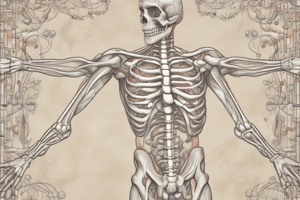Podcast
Questions and Answers
What are muscle relaxants used for?
What are muscle relaxants used for?
To relieve muscular spasms and the pain associated with these spasms.
What do centrally acting muscle relaxants primarily do?
What do centrally acting muscle relaxants primarily do?
Repress hyperactive reflexes.
What is spasticity?
What is spasticity?
A form of muscular hyperactivity causing painful muscle contractions.
Name two examples of centrally acting muscle relaxants.
Name two examples of centrally acting muscle relaxants.
Is cyclobenzaprine effective against muscle spasms caused by CNS disorders?
Is cyclobenzaprine effective against muscle spasms caused by CNS disorders?
What is the onset of action for cyclobenzaprine?
What is the onset of action for cyclobenzaprine?
What is the duration of action for cyclobenzaprine?
What is the duration of action for cyclobenzaprine?
What should be assessed before administering cyclobenzaprine?
What should be assessed before administering cyclobenzaprine?
Name one contraindication for the use of cyclobenzaprine.
Name one contraindication for the use of cyclobenzaprine.
What types of drugs should not be combined with cyclobenzaprine?
What types of drugs should not be combined with cyclobenzaprine?
Which of the following are common side effects of centrally acting muscle relaxants? (Select all that apply)
Which of the following are common side effects of centrally acting muscle relaxants? (Select all that apply)
What is the purpose of tapering muscle relaxants over a week?
What is the purpose of tapering muscle relaxants over a week?
Why should a patient taking muscle relaxants avoid driving?
Why should a patient taking muscle relaxants avoid driving?
Which lab values need monitoring based on the metabolism of cyclobenzaprine?
Which lab values need monitoring based on the metabolism of cyclobenzaprine?
Where is cyclobenzaprine excreted?
Where is cyclobenzaprine excreted?
Use of all muscle relaxants is contraindicated in patients with hepatic disease.
Use of all muscle relaxants is contraindicated in patients with hepatic disease.
What should patients report to their health care provider while taking muscle relaxants?
What should patients report to their health care provider while taking muscle relaxants?
What causes dizziness and fainting in patients taking muscle relaxants?
What causes dizziness and fainting in patients taking muscle relaxants?
How can a nurse show respect when offering information to Pacific Islanders?
How can a nurse show respect when offering information to Pacific Islanders?
What should a patient drink to help with gastrointestinal symptoms when taking a muscle relaxant?
What should a patient drink to help with gastrointestinal symptoms when taking a muscle relaxant?
What should patients on muscle relaxants do when changing positions?
What should patients on muscle relaxants do when changing positions?
What should patients be advised to avoid when taking cyclobenzaprine?
What should patients be advised to avoid when taking cyclobenzaprine?
What is the rationale for avoiding abrupt discontinuation of cyclobenzaprine?
What is the rationale for avoiding abrupt discontinuation of cyclobenzaprine?
Flashcards are hidden until you start studying
Study Notes
Overview of Skeletal Muscle Relaxants
- Muscle relaxants alleviate muscle spasms and associated pain, often resulting from traumatic injuries or chronic conditions (e.g., MS, CVA).
- Spasticity arises from increased muscle tone due to CNS stimulation or impaired inhibition in the spinal cord or muscles.
- These medications depress neuronal action in the spinal cord or brain and enhance inhibition in skeletal muscles.
Centrally Acting Muscle Relaxants
- Mechanism of action is not fully understood but targets hyperactive reflexes in spasticity.
- Used for muscle spasms unresponsive to anti-inflammatory drugs, physical therapy, or other treatments.
Spasticity
- Characterized by painful contractions and limited mobility, affecting skeletal muscles.
- Examples include Baclofen, Dantrolene, Tizanidine, and Diazepam for treatment of spasticity.
Muscle Spasms
- Many muscle relaxants decrease pain from muscle spasms and improve range of motion.
- Sedative effects are common; avoid combining with alcohol or other CNS depressants.
- Commonly prescribed muscle relaxants: Carisoprodol, Chlorzoxazone, Cyclobenzaprine, Metaxalone, Methocarbamol, Orphenadrine.
Cyclobenzaprine
- The most commonly used muscle relaxant for musculoskeletal injury-related spasms, ineffective for CNS disorder-related spasms.
- Likely blocks nerve impulses at the brainstem.
Pharmacokinetics of Cyclobenzaprine
- Onset: 1 hour; Peak concentration: 3-8 hours; Duration: 12-24 hours.
- Well-absorbed orally, 93% protein bound, metabolized in liver (half-life: 8-37 hours), and excreted in urine.
Assessment and Contraindications for Cyclobenzaprine
- Important to gather a thorough medical history and perform baseline vital signs prior to administration.
- Contraindications include cardiovascular disorders, hyperthyroidism, hepatic impairment, and use in individuals with specific conditions (e.g., narrow-angle glaucoma, children, spinal cord injuries).
Drug Interactions
- Increased CNS depression occurs when combined with alcohol, sedatives, MAOIs, or certain herbal supplements.
- Caution required to avoid overdose; consider interactions with tramadol and various herbs.
Dosage and Administration
- Available in 5 mg and 10 mg doses; extended-release formulations available.
- Standard dosage for adults: 5 mg PO tid, may increase to 10 mg if necessary; extended-release: 15-30 mg daily.
Adverse Effects
- Common effects: dizziness, drowsiness, fatigue, confusion, and muscle weakness.
- Serious reactions: allergic reactions, myocardial infarction, seizures.
- Recommendations to take with food or milk to mitigate gastrointestinal upset.
Patient Teaching
- Advise on the importance of tapering medication rather than abrupt cessation to prevent rebound spasms.
- Warn against driving or operating machinery due to sedative effects and potential dizziness.
- Emphasize avoiding alcohol and CNS depressants.
Cultural Considerations
- Teaching and prescription practices should respect cultural differences, e.g., using both hands when offering prescriptions to some cultures.
Case Study
- Example of a patient prescribed cyclobenzaprine for muscle spasms without relief from physical therapy and evaluated further through MRI.
Monitoring and Reporting
- Essential lab values to monitor include liver function tests.
- Patients should report adverse effects like headache and muscle weakness to prevent respiratory issues and manage side effects.
Safety and Position Changes
- Advise patients to change positions slowly to prevent syncope or dizziness.
- Hydration with milk is recommended for gastrointestinal symptoms related to medication.
Studying That Suits You
Use AI to generate personalized quizzes and flashcards to suit your learning preferences.




